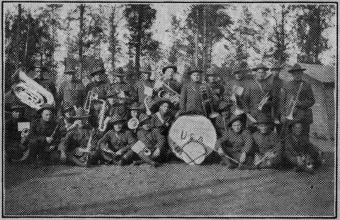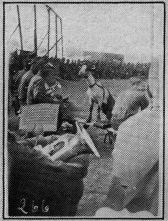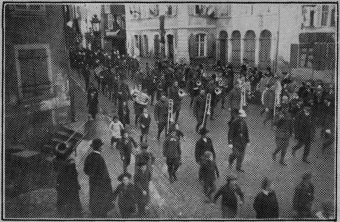

The Official Band
Note: Most of the content of this article comes from "TWENTIETH ENGINEERS -- FRANCE -- 1917-1918-1919"
The scheme of organization of the Forest Regiments included no provisions for an authorized Band, and perhaps no detail of the makeup of the Twentieth Engineers was more keenly felt its absence. With characteristic initiative, nearly every Battalion formed a volunteer Band, and some scattered single companies also boasted self-made martial music; but of all these, it fell to the lot of the youngest Band of all, that of the 43rd Engineers, later the 46th Co. Band, to inherit in part the glories that should have accrued to the march leaders of the greatest Regiment in history. Without ratings, chevrons, or release from normal fatigue duties, except on special occasions, nevertheless the 46th volunteer Band came to be known, wherever camps of the Twentieth were found, as the ''Official'' Band.

The "Official" Band, from the 46th Company, at Eclaron, France
Organized by recruits of the 42nd and 43rd Engineers, upon the initiative of Major H. L. Bowlby, the Band formed April 17th, 1918, at Camp American University. At Brest, June 7th, the personnel was transferred to Co. A, the 46th, and accompanied the unit to their station at Chatenois, in the Vosges. Until the Armistice, labor was too scarce for the services of thirty husky men to be spared, and it was only on completion of the allotted ten hours fatigue that the instruments came into action. Special occasions were excepted, and most of the nearby camps of the Twentieth were visited. For a time the Band was detailed for duty at Eclaron, and later at Granges, and the Armistice found them toiling at Vagney. News of the great event called for a celebration; ten minutes after the word arrived, the Band was leading an impromptu inter-allied parade through the village.

The "official" mascot--Billy--of the "official" band
From this time on, the Band received recognition in tangible ways. November 15th they were sent into Alsace, and for the first time the strains of the Star Spangled Banner sounded in conquered ground. Thanksgiving weekend the outfit was sent to participate in the celebrations attending the restoration of the Alsatian city of Richeauville to French rule. An uproarious procession, a concert and a dance, all pivoted upon the talent and endurance of the 46th Band.

With the Allied Troops Entering Richeauville, France
In December the "Special Detail" made a flying trip to Strasbourg, enjoying the distinction of being the first American troops to enter the capital of the rewon province. January was spent in a tour of all the Forestry camps in the Vosges--a tour cut short by abrupt orders to accompany Second Battalion Headquarters to the coast. Wild visions of a quick trip home faded after three weeks at St. Nazaire, when the outfit was ordered to the Spanish Border to play at the Luchon leave area. The stay at St. Nazaire was marked by an inspection by General Pershing, before whom the Band performed mightily, with 'Rosie O'Grady" on the lyres.
While at Luchon the outfit achieved the unusual distinction of crossing the Spanish border in uniform, and playing a concert at the College of San Jose. Leave area duty came to an end early in March, and the Band returned to St. Nazaire, whence it was ordered back to the Vosges. After six weeks of concerts distributed over the entire American section, from Vaux to the Woevre, and on to the Swiss border, the outfit rejoined the 46th Co. at Eclaron, May 8th, 1919. The long trip home began May 25th, reached its climax, the gangplank of U. S. S. ''Rhode Island,'' June 22nd, and closed at Camp Stewart, Va., July 6th.
During its fifteen months of existence, the band had performed, beside regular Engineer duties, these engagements: 311 Band Concerts, 53 vaudeville shows, 3 minstrel shows, 57 dances; Reveille 72 times, Retreat 10, guard mount 4, and two Battalion parades.